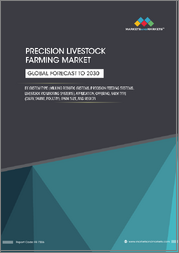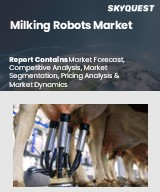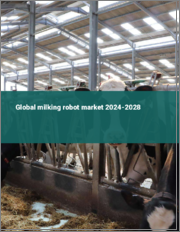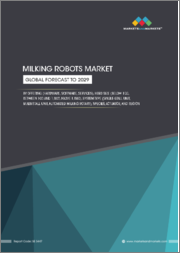
|
시장보고서
상품코드
1715160
세계의 착유 로봇 시장 : 시스템 유형별, 소군 규모별, 제공별, 지역별 분석, 규모, 동향, COVID-19의 영향, 예측(-2030년)Global Milking Robots Market: Analysis By System Type, By Herd Size, By Offering, By Region Size And Trends With Impact Of COVID-19 And Forecast Up To 2030 |
||||||
세계의 착유 로봇 시장 규모는 2024년에 32억 6,000만 달러였습니다. 착유 로봇은 착유 프로세스 전체를 사람의 개입 없이 수행하는 로봇 시스템입니다. 이 자동화 된 시스템은 로봇 암과 센서 기술을 사용하여 젖소의 자발적이고 노력이 필요없는 착유를 가능하게하고 낙농장의 효율성과 동물 복지를 향상시킵니다.
향후 수년간 세계의 착유 로봇 시장은 여러 동향의 수렴에 의해 성장을 계속할 것으로 예측됩니다. 센서 기술을 갖춘 착유 로봇은 완전 자동화된 착유 프로세스를 제공하고 수작업의 필요성을 줄이는 동시에 전반적인 효율성과 생산성을 향상시킵니다.농업의 근대화와 지속가능성의 촉진을 목적으로 한 정부의 지원 정책과 인센티브가, 정밀 낙농 기술에의 시프트를 가속시키고 있습니다. 이러한 요인이 맞추어, 세계의 착유 로봇 시장은 향후 수년간, 꾸준하고 지속적으로 성장할 전망입니다.
본 보고서에서는 세계의 착유 로봇 시장에 대한 조사 분석을 실시하고, 시장 역학, COVID-19의 영향, 경쟁 구도 등의 정보를 제공합니다.
목차
제1장 주요 요약
제2장 소개
- 착유 로봇: 개요
- 착유 로봇의 소개
- 착유 로봇의 유형
- 착유 로봇의 세분화: 개요
- 착유 로봇의 세분화
제3장 세계 시장 분석
- 세계의 착유 로봇 시장 : 분석
- 세계의 착유 로봇 시장 : 개요
- 세계의 착유 로봇 시장 규모
- 세계의 착유 로봇 시장 : 시스템 유형별(멀티 스톨 착유 시스템, 싱글 스톨 착유 시스템, 로터리 착유 시스템)
- 세계의 착유 로봇 시장 : 소군 규모별(100-1,000, 1,000 초과, 100 미만)
- 세계의 착유 로봇 시장 : 제공별(하드웨어, 소프트웨어, 서비스)
- 세계의 착유 로봇 시장 : 지역별(유럽, 아시아태평양, 북미, 기타 지역)
- 세계의 착유 로봇 시장 : 시스템 유형의 분석
- 세계의 착유 로봇 시장 : 시스템 유형별, 개요
- 세계의 멀티스톨 착유 로봇 시장 규모
- 세계의 싱글 스톨 착유 로봇 시장 규모
- 세계의 로터리식 착유 로봇 시장 규모
- 세계의 착유 로봇 시장 : 소군 규모의 분석
- 세계의 착유 로봇 시장 : 소군 규모별, 개요
- 세계의 100-1,000의 착유 로봇 시장 규모
- 세계의 100 미만의 착유 로봇 시장 규모
- 세계의 1,000개 이상의 착유 로봇 시장 규모
- 세계의 착유 로봇 시장 : 제공 분석
- 세계의 착유 로봇 시장 : 제공별, 개요
- 세계의 착유 로봇 하드웨어 시장 규모
- 세계의 착유 로봇 소프트웨어 시장 규모
- 세계의 착유 로봇 서비스 시장 규모
제4장 지역 시장 분석
- 유럽의 착유 로봇 시장 : 분석
- 유럽의 착유 로봇 시장 : 개요
- 유럽의 착유 로봇 시장 규모
- 유럽의 착유 로봇 시장 :지역별
- 독일의 착유 로봇 시장 규모
- 네덜란드의 착유 로봇 시장 규모
- 영국의 착유 로봇 시장 규모
- 프랑스의 착유 로봇 시장 규모
- 이탈리아의 착유 로봇 시장 규모
- 기타 유럽의 착유 로봇 시장 규모
- 아시아태평양의 착유 로봇 시장 : 분석
- 아시아태평양의 착유 로봇 시장 : 개요
- 아시아태평양의 착유 로봇 시장 규모
- 아시아태평양의 착유 로봇 시장 : 지역별
- 중국의 착유 로봇 시장 규모
- 인도의 착유 로봇 시장 규모
- 일본의 착유 로봇 시장 규모
- 한국의 착유 로봇 시장 규모
- 기타 아시아태평양 착유 로봇 시장 규모
- 북미의 착유 로봇 시장 : 분석
- 북미의 착유 로봇 시장 : 개요
- 북미의 착유 로봇 시장 규모
- 북미의 착유 로봇 시장 : 지역별
- 미국의 착유 로봇 시장 규모
- 캐나다의 착유 로봇 시장 규모
- 멕시코의 착유 로봇 시장 규모
- 기타 지역의 착유 로봇 시장 : 분석
- 기타 지역의 착유 로봇 시장 : 개요
- 기타 지역의 착유 로봇 시장 규모
제5장 COVID-19의 영향
- 세계의 착유 로봇 시장에 대한 COVID-19의 영향
- 세계의 착유 로봇 시장에 대한 COVID-19 이후의 영향
제6장 시장 역학
- 성장 촉진요인
- 우유 및 유제품 수요 증가
- 인건비 삭감에 주목의 고조
- 낙농업무에 있어서의 동물복지의 중시
- 재정적 인센티브와 정부에 의한 지원의 이용 가능성
- 숙련 낙농 노동자의 부족 확대
- 효율성과 생산성에 대한 주목의 급증
- 과제
- 높은 초기 설치비와 유지비
- 기술적인 전문지식과 트레이닝의 부족
- 기존 농장 인프라와의 통합
- 시장 동향
- 스마트 농업 기술의 채용의 진행
- 아그리텍 스타트업과 R&D 투자 증가
- 데이터 통합에 의한 소군 관리의 개량
- 대규모 낙농장의 성장
- 로보틱스와 자동화에 있어서의 기술의 진보
- 지속가능성과 카본실적 삭감에 대한 주목의 향상
제7장 경쟁 구도
- 세계의 착유 로봇 시장 : 경쟁 구도
제8장 기업 프로파일
- Tetra Laval International SA(DeLaval)
- GEA Group AG
- Nedap Livestock Management
- Lely International NV
- BouMatic LLC
- Dairymaster Ltd.
- Fullwood JOZ BV
- Hokofarm Group
- Waikato Milking Systems NZ LP
- Afimilk Agricultural Cooperative Ltd.
- Milkplan SA
- Milkomax Solutions Laitieres Inc.
The global milking robots market was valued at US$3.26 billion in 2024. The market value is expected to reach US$7.04 billion by 2030. Milking robots are robotic systems that perform the entire milking process without direct human labor. These automated systems enable voluntary, labor-free milking of dairy cows using robotic arms and sensor technology, enhancing efficiency and animal welfare on dairy farms.
In the forthcoming years, the global milking robots market is expected to continue growing due to several converging trends. A key factor driving this growth is the rising demand for automation in the agricultural sector, particularly in dairy farming, where labor shortages and increasing operational costs are prompting farmers to adopt automated solutions. Milking robots, equipped with robotic arms and advanced sensor technologies, offer a fully automated milking process that reduces the need for manual labor while improving overall efficiency and productivity. Furthermore, the integration of data analytics and herd management tools into these systems is helping farmers monitor milk quality and animal health in real time, enabling more informed decision-making. Technological advancements in robotics, artificial intelligence, and IoT are making these systems increasingly reliable and cost-effective, broadening their adoption among both large and mid-sized dairy farms. In addition, supportive government policies and incentives aimed at promoting agricultural modernization and sustainability are accelerating the shift toward precision dairy farming technologies. Together, these factors are positioning the global milking robots market for steady and sustained growth in the years ahead. The market is expected to grow at a CAGR of approx. 14% during the forecasted period of 2025-2030.
Market Segmentation Analysis:
By System Type: The report provides the bifurcation of the milking robots market into three segments on the basis of system type: Single-Stall Milking System, Multi-Stall Milking System and Rotary Milking System. The multi-stall segment holds the highest share in the market, due to its ability to milk multiple cows simultaneously, improving operational efficiency, reducing labor costs, and providing a quicker return on investment. The growth of this segment is driven by the increasing demand for dairy products, the shift toward automation, and the need for higher milking efficiency to meet rising production demands. Moving forward, the multi-stall system is expected to maintain its dominance as large-scale dairy operations continue to grow, with advancements in technology further improving system efficiency. Integration with herd management software and real-time monitoring tools will further enhance its appeal, particularly in industrialized dairy farming regions.
By Herd Size: The report provides the bifurcation of the milking robots market into three segments on the basis of herd size: Below 100, Between 100-1000 and Above 1000. The between 100-1000 segment held a significant share of the global market, as it represents medium-sized dairy farms that benefit significantly from milking robots' ability to optimize labor costs and improve milking throughput. These systems allow dairy farmers to manage larger herds more efficiently, while reducing the dependency on manual labor. The growth of this segment is driven by increasing demand for dairy products, a shift toward automation in the dairy industry, and the need for higher milking efficiency to meet growing production needs. In the coming years, this segment is expected to maintain its dominant position, supported by the continued push for operational efficiency, technological innovations, and reduced installation and operational costs.
By Offering: The report provides the bifurcation of the milking robots market into three segments on the basis of offering: Hardware, Software and Service. The hardware segment holds the largest share in the market as it encompasses the physical components essential for milking robots, such as robotic arms, sensors, and milking units. The segment is particularly supported by the need for efficiency in high-throughput environments and the adoption of systems that reduce manual intervention. In the coming years, growth is expected to be driven by technological advancements in hardware components, such as precision sensors and energy-efficient designs, which enhance operational efficiency. Additionally, economies of scale and decreasing manufacturing costs are predicted to make hardware more accessible and attractive to dairy farms, supporting continued market expansion.
By Region: In the report, the global milking robots market is divided into four regions: Europe (Germany, Netherlands, UK, France, Italy, and Rest of Europe), Asia Pacific (China, India, Japan, South Korea, and rest of Asia Pacific), North America (the US, Canada, and Mexico), and Rest of the World. In 2024, the Europe region led the milking robots market, propelled by propelled by advanced dairy farming practices, strong technological infrastructure, and a high rate of automation adoption across countries such as Germany, the Netherlands, and France. Government support through subsidies and favorable policies for modernizing agriculture further encouraged the use of robotic milking systems. Additionally, the region's focus on animal welfare, labor efficiency, and sustainable farming practices contributed to the widespread implementation of automated solutions, solidifying Europe's position at the forefront of the milking robots market.
During 2025-2030, the US is expected to maintain its lead within the North American milking robots market, driven by the increasing adoption of precision farming technologies, growing labor shortages in the agricultural sector, and rising demand for efficient and scalable dairy operations. Investments in smart farming solutions and strong R&D capabilities are further accelerating the deployment of automated milking systems.
Market Dynamics:
Growth Drivers: The global milking robots market growth is predicted to be supported by numerous growth drivers such as growing demand for milk and dairy products, heightened focus on reducing labor costs, increasing emphasis on animal welfare, availability of financial incentives and government support, expanding scarcity of skilled dairy labor, and many other factors. One of the key factors driving the growth of the global milking robots market is the surging focus on efficiency and productivity. Milking robots enable faster, more consistent, and round-the-clock milking, allowing farms to optimize milk yield while reducing reliance on manual labor. By automating the milking process and integrating real-time monitoring of animal health and milk quality, these systems help farmers improve overall herd management, minimize downtime, and maximize output. This heightened operational efficiency not only lowers production costs but also enhances profitability, making milking robots an attractive investment, thereby significantly contributing to the market's growth.
Challenges: However, the market growth would be negatively impacted by various challenges such as high initial cost of installation and maintenance, lack of technical expertise and training, integration with existing farm infrastructure, etc.
Trends: The market is projected to grow at a fast pace during the forecast period, due to various latest trends such as rising investment in agritech startups and R&D, improved herd management through data integration, technological advancements in robotics and automation, growth of large-scale dairy farms, intensifying focus on sustainability and carbon footprint reduction, etc. The ongoing adoption of smart farming technologies is becoming a key trend in the milking robots market. These technologies integrate sensors, IoT, and data analytics to provide real-time insights into animal health, milk quality, and equipment performance, enabling farmers to make data-driven decisions. By streamlining operations and improving accuracy, smart farming enhances productivity and reduces operational inefficiencies. This digital transformation in dairy farming is expected to accelerate the adoption of automated milking systems, thereby playing a vital role in driving market growth during the forecast period.
Competitive Landscape:
The global milking robots market is moderately consolidated, with a few key players holding substantial market share, but it remains highly innovative due to ongoing advancements in smart farming technologies and automation.
The key players in the global milking robots market are:
Tetra Laval International SA (DeLaval)
GEA Group AG
Nedap Livestock Management
Lely International NV
BouMatic LLC
Dairymaster Ltd.
Fullwood JOZ B
Hokofarm Group
Waikato Milking Systems NZ LP
Afimilk Agricultural Cooperative Ltd.
Milkplan SA
Milkomax Solutions Laitieres Inc.
The key players focus on technological innovation, product expansion, and strategic partnerships to maintain a competitive edge. Meanwhile, emerging players are entering the market with region-specific solutions and cost-effective alternatives, gradually intensifying competition. For instance, in September 2024, Lely unveiled the Zeta concept, a revolutionary system that utilizes cameras, LED lighting, artificial intelligence, and smart algorithms to monitor cows and barn operations. This innovation aims to improve animal welfare and farmer prosperity by providing real-time data and insights. Similarly, in January 2024, DeLaval introduced the VMS Batch Milking system, designed to efficiently milk larger groups of cows by dividing herds into groups and bringing them to the milking center, similar to traditional parlor or rotary milking. This system has been installed on over 10 farms worldwide, milking a total of 10,000 cows.
Table of Contents
1. Executive Summary
2. Introduction
- 2.1 Milking Robots: An Overview
- 2.1.1 Introduction to Milking Robots
- 2.1.2 Types of Milking Robots
- 2.2 Milking Robots Segmentation: An Overview
- 2.2.1 Milking Robots Segmentation
3. Global Market Analysis
- 3.1 Global Milking Robots Market: An Analysis
- 3.1.1 Global Milking Robots Market: An Overview
- 3.1.2 Global Milking Robots Market by Value
- 3.1.3 Global Milking Robots Market by System Type (Multi-Stall Milking System, Single-Stall Milking System and Rotary Milking System)
- 3.1.4 Global Milking Robots Market by Herd Size (Between 100-1000, Above 1000 and Below 100)
- 3.1.5 Global Milking Robots Market by Offering (Hardware, Software and Services)
- 3.1.6 Global Milking Robots Market by Region (Europe, Asia Pacific, North America, and rest of the World)
- 3.2 Global Milking Robots Market: System Type Analysis
- 3.2.1 Global Milking Robots Market by System Type: An Overview
- 3.2.2 Global Multi-Stall Milking Robots Market by Value
- 3.2.3 Global Single-Stall Milking Robots Market by Value
- 3.2.4 Global Rotary Milking Robots Market by Value
- 3.3 Global Milking Robots Market: Herd Size Analysis
- 3.3.1 Global Milking Robots Market by Herd Size: An Overview
- 3.3.2 Global Between 100-1000 Milking Robots Market by Value
- 3.3.3 Global Below 100 Milking Robots Market by Value
- 3.3.4 Global Above 1000 Milking Robots Market by Value
- 3.4 Global Milking Robots Market: Offering Analysis
- 3.4.1 Global Milking Robots Market by Offering: An Overview
- 3.4.2 Global Milking Robots Hardware Market by Value
- 3.4.3 Global Milking Robots Software Market by Value
- 3.4.4 Global Milking Robots Services Market by Value
4. Regional Market Analysis
- 4.1 Europe Milking Robots Market: An Analysis
- 4.1.1 Europe Milking Robots Market: An Overview
- 4.1.2 Europe Milking Robots Market by Value
- 4.1.3 Europe Milking Robots Market by Region
- 4.1.4 Germany Milking Robots Market by Value
- 4.1.5 Netherlands Milking Robots Market by Value
- 4.1.6 The UK Milking Robots Market by Value
- 4.1.7 France Milking Robots Market by Value
- 4.1.8 Italy Milking Robots Market by Value
- 4.1.9 Rest of Europe Milking Robots Market by Value
- 4.2 Asia Pacific Milking Robots Market: An Analysis
- 4.2.1 Asia Pacific Milking Robots Market: An Overview
- 4.2.2 Asia Pacific Milking Robots Market by Value
- 4.2.3 Asia Pacific Milking Robots Market by Region
- 4.2.4 China Milking Robots Market by Value
- 4.2.5 India Milking Robots Market by Value
- 4.2.6 Japan Milking Robots Market by Value
- 4.2.7 South Korea Milking Robots Market by Value
- 4.2.8 Rest of Asia Pacific Milking Robots Market by Value
- 4.3 North America Milking Robots Market: An Analysis
- 4.3.1 North America Milking Robots Market: An Overview
- 4.3.2 North America Milking Robots Market by Value
- 4.3.3 North America Milking Robots Market by Region
- 4.3.4 The US Milking Robots Market by Value
- 4.3.5 Canada Milking Robots Market by Value
- 4.3.6 Mexico Milking Robots Market by Value
- 4.4 Rest of the World Milking Robots Market: An Analysis
- 4.4.1 Rest of the World Milking Robots Market: An Overview
- 4.4.2 Rest of the World Milking Robots Market by Value
5. Impact of COVID-19
- 5.1 Impact of COVID-19 on Global Milking Robots Market
- 5.2 Post COVID-19 Impact on Global Milking Robots Market
6. Market Dynamics
- 6.1 Growth Drivers
- 6.1.1 Growing Demand for Milk and Dairy Products
- 6.1.2 Heightened Focus on Reducing Labor Costs
- 6.1.3 Increasing Emphasis on Animal Welfare in Dairy Operations
- 6.1.4 Availability of Financial Incentives and Government Support
- 6.1.5 Expanding Scarcity of Skilled Dairy Labor
- 6.1.6 Surging Focus on Efficiency and Productivity
- 6.2 Challenges
- 6.2.1 High Initial Cost of Installation and Maintenance
- 6.2.2 Lack of Technical Expertise and Training
- 6.2.3 Integration with Existing Farm Infrastructure
- 6.3 Market Trends
- 6.3.1 Ongoing Adoption of Smart Farming Technologies
- 6.3.2 Rising Investment in AgriTech Startups and R&D
- 6.3.3 Improved Herd Management through Data Integration
- 6.3.4 Growth of Large-Scale Dairy Farms
- 6.3.5 Technological Advancements in Robotics and Automation
- 6.3.6 Intensifying Focus on Sustainability and Carbon Footprint Reduction
7. Competitive Landscape
- 7.1 Global Milking Robots Market: Competitive Landscape
8. Company Profiles
- 8.1 Tetra Laval International SA (DeLaval)
- 8.1.1 Business Overview
- 8.1.2 Operating Segments
- 8.1.3 Business Strategy
- 8.2 GEA Group AG
- 8.2.1 Business Overview
- 8.2.2 Operating Segments
- 8.2.3 Business Strategy
- 8.3 Nedap Livestock Management
- 8.3.1 Business Overview
- 8.3.2 Operating Region
- 8.3.3 Business Strategy
- 8.4 Lely International NV
- 8.4.1 Business Overview
- 8.4.2 Business Strategy
- 8.5 BouMatic LLC
- 8.5.1 Business Overview
- 8.5.2 Business Strategy
- 8.6 Dairymaster Ltd.
- 8.6.1 Business Overview
- 8.6.2 Business Strategy
- 8.7 Fullwood JOZ BV
- 8.7.1 Business Overview
- 8.7.2 Business Strategy
- 8.8 Hokofarm Group
- 8.8.1 Business Overview
- 8.8.2 Business Strategy
- 8.9 Waikato Milking Systems NZ LP
- 8.9.1 Business Overview
- 8.9.2 Business Strategy
- 8.10 Afimilk Agricultural Cooperative Ltd.
- 8.9.1 Business Overview
- 8.11 Milkplan SA
- 8.11.1 Business Overview
- 8.12 Milkomax Solutions Laitieres Inc.
- 8.12.1 Business Overview



















